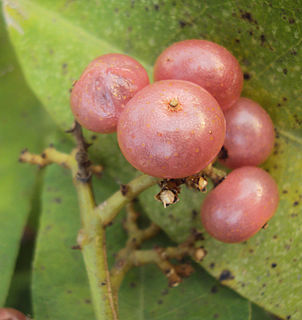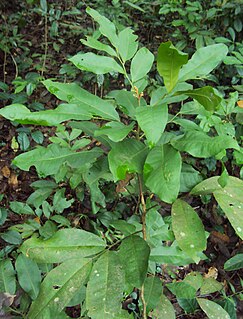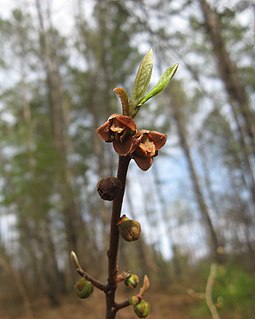
Pinus parviflora, also known as five-needle pine, Ulleungdo white pine, or Japanese white pine, is a pine in the white pine group, Pinus subgenus Strobus, native to Korea and Japan.

Pinus pumila, commonly known as the Siberian dwarf pine, dwarf Siberian pine, dwarf stone pine, Japanese stone pine, or creeping pine, is a tree in the family Pinaceae native to northeastern Asia and the Japanese isles. It shares the common name creeping pine with several other plants.

Dipterocarpus retusus, commonly known as hollong, is a large tree and perhaps the best known species in the genus Dipterocarpus. It is native to China, Vietnam, Philippines, Laos, Cambodia, Malaysia, Indonesia, Myanmar, and India. The tree, some 20–30 metres (70–100 ft) tall, is found in Cambodia in dense forests of the plains, common on hillsides and along rivers and in forests between 800 m (2,600 ft) and 1,500 m (5,000 ft) altitude.

Aesculus parviflora, the bottlebrush buckeye, is a species of suckering deciduous shrub in the family Sapindaceae. The species is native to the southeastern United States, where it is found primarily in Alabama and Georgia, with a disjunct population in South Carolina along the Savannah River. Its natural habitat is in mesic forests, on bluffs and in ravines.

Oenothera curtiflora, known as velvetweed, velvety gaura, downy gaura, or smallflower gaura, is a species of flowering plant native to the central United States and northern Mexico, from Nebraska and Wyoming south to Durango and Nuevo Leon.
Glycosmis crassifolia is a species of plant in the family Rutaceae. It is a tree endemic to Peninsular Malaysia. It is threatened by habitat loss.

Glycosmis is a genus of flowering plants in the citrus family, Rutaceae and tribe Clauseneae. It is in the subfamily Aurantioideae, which also includes genus Citrus. It is a genus of the subtribe Clauseninae, which are known technically as the remote citroid fruit trees.
Glycosmis decipiens is a species of plant in the family Rutaceae. It is endemic to Peninsular Malaysia. It is threatened by habitat loss. A population is protected in Taman Negara.
Glycosmis monticola is a species of plant in the family Rutaceae. It is endemic to Peninsular Malaysia. It is threatened by habitat loss.
Glycosmis perakensis is a species of plant in the family Rutaceae. It is a tree endemic to Peninsular Malaysia. It is threatened by habitat loss.
Glycosmis tomentella is a species of plant in the family Rutaceae. It is endemic to Peninsular Malaysia. It is threatened by habitat loss.

Hopea parviflora is a species of plant in the family Dipterocarpaceae. It is endemic to India. It is called 'kampakam' or 'thampakam' in Malayalam and கோங்கு 'vellaikongu' or 'irubogam' in Tamil. Hopea parviflora is a tree growing 30 – 37 metres tall. The bole can be 150 cm in diameter. The tree produces a beautiful timber and is commonly harvested from the wild, both for local use and for trade. The plant is classified as 'Endangered' in the IUCN Red List of Threatened Species.
Puya parviflora is a species of plant in the family Bromeliaceae. It is endemic to Ecuador. Its natural habitats are subtropical or tropical moist montane forests and subtropical or tropical high-altitude shrubland. It is threatened by habitat loss.

Vitex parviflora is a species of plant in the family Verbenaceae, also known as smallflower chastetree or the molave tree. It is found in Indonesia, Malaysia, and the Philippines. It is threatened by habitat loss. The name "molave" is from Spanish, derived from Tagalog mulawin. It is also known as tugas in Visayan languages.

Agave parviflora is a species of succulent perennial flowering plant in the asparagus family, known by the common names Santa Cruz striped agave, smallflower century plant, and small-flower agave. It is native to Arizona in the United States and Sonora in Mexico.

Glycosmis pentaphylla is a species of flowering plant in the family Rutaceae, known commonly as orangeberry and gin berry. It occurs in Southeast Asia and northern Australia. It is cultivated for its edible pink fruits. In temperate zones, it can be cultivated indoors as a houseplant.

Halesia carolina, commonly called Carolina silverbell or little silverbell, is a species of flowering plant in the family Styracaceae, native to the southeastern United States.

Asimina parviflora, the smallflower pawpaw, is a shrub or small tree in the custard apple family.

Bruguiera parviflora is a tree in the family Rhizophoraceae. The specific epithet parviflora is from the Latin meaning "small flowers".
Schizolaena parviflora is a tree in the family Sarcolaenaceae. It is endemic to Madagascar. The specific epithet parviflora is from the Latin meaning "small flowers".














